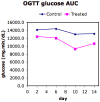Differential effects of thiazolidinediones on adipocyte growth and recruitment in Zucker fatty rats
- PMID: 20041138
- PMCID: PMC2794370
- DOI: 10.1371/journal.pone.0008196
Differential effects of thiazolidinediones on adipocyte growth and recruitment in Zucker fatty rats
Abstract
Background: Adipose tissue grows by two mechanisms: hyperplasia (cell number increase) and hypertrophy (cell size increase). Thiazolidinediones are insulin-sensitizing peroxisome proliferator-activated receptor gamma agonists that are known to affect the morphology of adipose tissue.
Methodology: In this study, adipose cell-size probability distributions were measured in six Zucker fa/fa rats over a period of 24 days, from four weeks of age, using micro-biopsies to obtain subcutaneous (inguinal) fat tissue from the animals. Three of the rats were gavaged daily with rosiglitazone, a thiazolidinedione, and three served as controls. These longitudinal probability distributions were analyzed to obtain the rate of increase in cell-size diameter in rosiglitazone-treated animals, and the hyperplasia induced by treatment quantitatively.
Conclusions: We found that treatment leads to hypertrophy that leads to an approximately linear rate of cell diameter increase (2 m/day), and that the hyperplasia evident in treated animals occurs largely within the first eight days of treatment. The availability of additional lipid storage due to treatment may alleviate lipotoxicity and thereby promote insulin sensitivity. The hypothesis that a TZD regimen involving repeated treatments of limited duration may suffice for improvements in insulin sensitivity merits further investigation.
Conflict of interest statement
Figures





 –-for example, the curve labeled (day 12 – day 8) shows Prob(day 12,
–-for example, the curve labeled (day 12 – day 8) shows Prob(day 12,  ) – Prob(day 8,
) – Prob(day 8,  ).
).

 m/day whereas the log-likelihood values are highest around 2
m/day whereas the log-likelihood values are highest around 2  m/day for treated animals.
m/day for treated animals.




Similar articles
-
Mechanism by which a novel non-thiazolidinedione peroxisome proliferator-activated receptor gamma agonist, FK614, ameliorates insulin resistance in Zucker fatty rats.Diabetes Obes Metab. 2007 May;9(3):369-78. doi: 10.1111/j.1463-1326.2006.00619.x. Diabetes Obes Metab. 2007. PMID: 17391165
-
Insulin-sensitizing effect of rosiglitazone (BRL-49653) by regulation of glucose transporters in muscle and fat of Zucker rats.Metabolism. 2001 Nov;50(11):1294-300. doi: 10.1053/meta.2001.27202. Metabolism. 2001. PMID: 11699047
-
Pioglitazone-induced increase of insulin sensitivity in the muscles of the obese Zucker fa/fa rat cannot be explained by local adipocyte differentiation.Diabetologia. 1998 Aug;41(8):963-8. doi: 10.1007/s001250051014. Diabetologia. 1998. PMID: 9726600
-
The influence of thiazolidinediones on adipogenesis in vitro and in vivo: potential modifiers of intramuscular adipose tissue deposition in meat animals.J Anim Sci. 2008 Apr;86(14 Suppl):E236-43. doi: 10.2527/jas.2007-0219. Epub 2007 Aug 8. J Anim Sci. 2008. PMID: 17686902 Review.
-
Central role of the adipocyte in the insulin-sensitising and cardiovascular risk modifying actions of the thiazolidinediones.Biochimie. 2003 Dec;85(12):1219-30. doi: 10.1016/j.biochi.2003.10.010. Biochimie. 2003. PMID: 14739074 Review.
Cited by
-
Chemical-shift water-fat MRI of white adipose depots: inability to resolve cell size differences.Int J Body Compos Res. 2013;11(1):9-16. Int J Body Compos Res. 2013. PMID: 23667321 Free PMC article.
-
Quantitative dynamics of adipose cells.Adipocyte. 2012 Apr 1;1(2):80-88. doi: 10.4161/adip.19705. Adipocyte. 2012. PMID: 23700516 Free PMC article.
-
Effects of dietary thiazolidinedione supplementation on growth performance, intramuscular fat and related genes mRNA abundance in the longissimus dorsi muscle of finishing pigs.Asian-Australas J Anim Sci. 2013 Jul;26(7):1012-20. doi: 10.5713/ajas.2012.12722. Asian-Australas J Anim Sci. 2013. PMID: 25049880 Free PMC article.
-
Subchronic treatment of rats with oxytocin results in improved adipocyte differentiation and increased gene expression of factors involved in adipogenesis.Br J Pharmacol. 2011 Jan;162(2):452-63. doi: 10.1111/j.1476-5381.2010.01037.x. Br J Pharmacol. 2011. PMID: 20846187 Free PMC article.
-
Effects of PPAR γ Agonist Pioglitazone on Redox-Sensitive Cellular Signaling in Young Spontaneously Hypertensive Rats.PPAR Res. 2013;2013:541871. doi: 10.1155/2013/541871. Epub 2013 Dec 19. PPAR Res. 2013. PMID: 24454335 Free PMC article.
References
-
- Andersson CX, Gustafson B, Hammarstedt A, Hedjazifar S, Smith U. Inflamed adipose tissue, insulin resistance and vascular injury. Diabetes Metab Res Rev. 2008;24:595–603. - PubMed
-
- Jiang G, Dallas-Yang Q, Li Z, Szalkowski D, Liu F, et al. Potentiation of insulin signaling in tissues of Zucker obese rats after acute and long-term treatment with PPARgamma agonists. Diabetes. 2002;51:2412–9. - PubMed
-
- Hallakou S, Doaré L, Foufelle F, Kergoat M, Guerre-Millo M, et al. Pioglitazone induces in vivo adipocyte differentiation in the obese Zucker fa/fa rat. Diabetes. 1997;46:1393–9. - PubMed
-
- de Souza CJ, Eckhardt M, Gagen K, Dong M, Chen W, et al. Effects of pioglitazone on adipose tissue remodeling within the setting of obesity and insulin resistance. Diabetes. 2001;50:1863–71. - PubMed
Publication types
MeSH terms
Substances
Grants and funding
LinkOut - more resources
Full Text Sources

